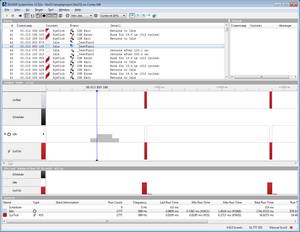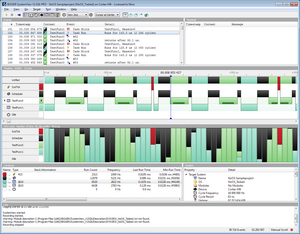Use SystemView without RTOS
SystemView works best when using it with one of our out-of-the-box supported RTOS' like embOS. However it is also possible to instrument a generic application without any RTOS present. That way SystemView can give deeper insight into any application type. The following article will explain how.
Contents
General information
If you are looking to record only interrupt calls of your application then this guide is not needed. Simply follow the steps described in the SystemView user guide UM08027. In all other cases continue with the guide.
Prerequisites for the guide
- SystemView V2.52a or later
- Embedded Studio V3.40 or later
- Any J-Link/J-Trace debug probe
- Cortex-M Trace Reference Board or any other target hardware based on ST STM32F407
How to instrument a "NoOS" application with SystemView
The reference project which should be the result of this guide can be found here: Reference Project
The example description file for the example project can be found here: SYSVIEW_NoOS.txt
It is designed to be as generic as possible so any Cortex-M4 device can be used with that project. Just make sure that the target device name is changed accordingly.
GUIDE:
- Open Embedded Studio and create a new project for your device.
- Add SystemView Sources to your project. Specifically the folders /SEGGER, /Config and in this case the Sample/NoOS/Config/Cortex-M/SEGGER_SYSVIEW_Config_NoOS.c.
- Create a new file in $(SystemViewData) (%APPDATA%\SEGGER on Windows) or in $(SystemViewInstDir)/Description called SYSVIEW_NoOS.txt, add all functions that shall be recorded with SystemView to that file with IDs starting at 33.
- Include SEGGER_SYSVIEW_Conf.h and SEGGER_SYSVIEW.h in your main.c.
- Edit SEGGER_SYSVIEW_ID_BASE to your actual RAM address on your device in SEGGER_SYSVIEW_Conf.h.
- In SEGGER_SYSVIEW_Config_NoOS.c. edit in function _cbSendSystemDesc(), SEGGER_SYSVIEW_SendSysDesc("N="SYSVIEW_APP_NAME",D="SYSVIEW_DEVICE_NAME); to SEGGER_SYSVIEW_SendSysDesc("N="SYSVIEW_APP_NAME",O=NoOS,D="SYSVIEW_DEVICE_NAME);
- In the same file edit SYSVIEW_RAM_BASE to the actual RAM Base address of your target device
- Call SEGGER_SYSVIEW_Conf(); in your main() function
- As this is a NoOS application the whole main() function will be treated as system idle, to enable this call SEGGER_SYSVIEW_OnIdle(); next.
- Optional: Initialize Systick in your main application. Use SEGGER_SYSVIEW_RecordEnterISR(); at the beginning of Systick_Handler and SEGGER_SYSVIEW_RecordExitISR(); at the end.
- Call the functions that shall be recorded in your application.
- In each function from the description list call SEGGER_SYSVIEW_RecordVoid(ID); first upon entry and SEGGER_SYSVIEW_RecordEndCall(ID); at the end of each function where ID is the ID number in your description file.
- Run your application and start a SystemView recoding.
If everything was implemented as described your SystemView recording should look similar to the following picture:
How to instrument a "NoOS" application with SystemView using "tasks"
The reference project which should be the result of this guide can be found here: Reference Project
The project is designed to be as generic as possible so any Cortex-M4 device can be used with that project. Just make sure that the target device name is changed accordingly.
GUIDE:
- Open Embedded Studio and create a new project for your device.
- Add SystemView Sources to your project. Specifically the folders /SEGGER, /Config and in this case the Sample/NoOS/Config/Cortex-M/SEGGER_SYSVIEW_Config_NoOS.c.
- Include SEGGER_SYSVIEW_Conf.h and SEGGER_SYSVIEW.h in your main.c.
- Edit SEGGER_SYSVIEW_ID_BASE to 0x0 in SEGGER_SYSVIEW_Conf.h.
- In file SEGGER_SYSVIEW_Config_NoOS.c add a SEGGER_SYSVIEW_OS_API pointer e.g. as "static const SEGGER_SYSVIEW_OS_API _NoOSAPI = {NULL, _cbSendTaskList};". Include stdio.h and string.h.
- In the same file create a static void _cbSendTaskList(void); function that sends all "task" information with SEGGER_SYSVIEW_SendTaskInfo.
- "Tasks" in this context are all functions called directly from main. Nested functions can be added using the API Descriptions approach in the prior guide.
- Call SEGGER_SYSVIEW_Conf(); in your main() function
- Next SEGGER_SYSVIEW_OnTaskCreate() needs to be called for each "Task" function. We recommend creating a helper function for this task e.g. SYSVIEW_AddTask in the example project.
- Optional: Initialize Systick in your main application. Use SEGGER_SYSVIEW_RecordEnterISR(); at the beginning of Systick_Handler and SEGGER_SYSVIEW_RecordExitISR(); at the end.
- Call the "tasked" functions that shall be recorded in your application.
- Optional: Call SEGGER_SYSVIEW_RecordVoid() and SEGGER_SYSVIEW_RecordEndCall() in your state machine to record nested functions as well.
- Run your application and start a SystemView recoding.
If everything was implemented as described your SystemView recording should look similar to the following picture:
Troubleshooting
I receive invalid packets. How can this happen?
- Invalid packets are mostly generated by the target system due to either one of two reasons:
- SystemView does not correctly lock when recording an event and is interrupted by another event. In this case make sure SEGGER_SYSVIEW_LOCK() and SEGGER_RTT_LOCK() are configured correctly for your device.
- The system goes into sleep or low-power mode and the J-Link cannot correctly access the RAM to read the SystemView buffer. It is recommended to not use WFI or any low-power mode while a debug probe is connected to the system.
I get overflow events when continuously recording. How can I prevent this?
- Overflow events occur when the SystemView RTT buffer is full. This can happen for following reasons:
- J-Link is kept busy by a debugger and cannot read the data fast enough.
- The target interface speed is too low to read the data fast enough.
- The application generates too many events to fit into the buffer.
- To prevent this:
- Minimize the interactions of the debugger with J-Link while the target is running. (i.e. disable live watches)
- Select a higher interface speed in all instances connected to J-Link. (i.e. The debugger and SystemView)
- Choose a larger buffer for SystemView. (1 - 4 kByte)
- Run SystemViewer stand-alone without a debugger.
My application crashes when I connect SystemView. What might be wrong?
- Make sure ~200 Bytes of stack are available for SystemView in every context (Task, Interrupt, Scheduler) which can create SystemView events.
I cannot start recording in SystemView. What might be wrong?
- Possible reasons are:
- J-Link or target is not connected: Make sure all connections are okay.
- The target is not running: Make sure the target is running, otherwise connection might fail or the RTT Control Block can not be found.
- The SystemView module is not configured: Make sure the SystemView module is included in your application and SEGGER_SYSVIEW_Conf() is called at the start of the application.
- The J-Link Software is out-of-date: Make sure you have the latest J-Link Software and Documentation Package installed.

